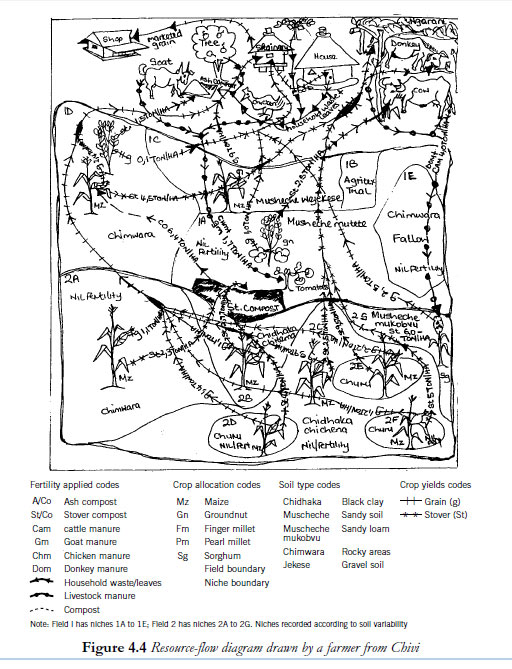There is no doubt that changes in soil structure, losses through erosion and soil fertility decline are important issues. But these global figures are derived from some dubious calculations that are often rather meaningless. Aggregated up from multiple small studies, they say nothing about how soil and nutrients move around landscapes; they say nothing about how soil nutrients are made available in different settings; and they say nothing about the net effects on livelihoods given people’s adaptive capacities.
These endless presentation of these dubious figures irk me especially because we spent a long time in the late 1990s and early 2000s trying to generate a more sophisticated debate about soil fertility in African agriculture. In 1999, Camilla Toulmin and I asked whether nutrient budgeting has any use for policy. In the same year, we did a report for DFID on the subject. In 2001, a major book, Dynamics and Diversity: Soil Fertility and Farming Livelihoods in Africa, (pdf here) followed. This offers an overall summary of the extensive field research from Ethiopia, Mali and Zimbabwe. The follow-up 2003 book, Understanding Environmental Policy Processes: Cases from Africa, (pdf here) offered reflections on the politics of policy around soils and land degradation, with cases again from the same countries. These issues were further debated in 2008 as part of a Future Agricultures Consortium convened e-debate.
In a series of four forthcoming blogs, I will highlight some of the issues raised and draw on the discussions in the e-debate. These remain as pertinent today as they did then. The bottom-line message is that we should base our understandings and response on what is happening on the ground, not on simplistic, aggregated assessments based on problematic nutrient accounting techniques or soil erosion and degradation measures calculated at inappropriate scales, often based on remote sensing and mapping that cannot get to grips with the variegated patterns of soils.
Instead a social and technical analysis is more appropriate a farm and landscape level, where we can gauge how people use and manage soils, and find ways to improve soil quality – including soil organic composition, structure, biodiversity, and nutrients (macro and micro). Soils are immensely complex ecosystems, and so are management responses by farmers, who have deep and intimate knowledge of these vital resources.
Rejecting the headline numbers and questioning the rhetoric about soil degradation (and desertification and the rest) does not mean to say that I do not think that these are pressing and important problems, as some have tried to argue in the past. Quite the opposite. I just think that an appropriate diagnosis of the problem leads to better solutions, and that the alarmist, generalised, disaster oriented statistics can lead to the wrong, and often highly damaging, responses.
There is a long history of this in Africa and in Zimbabwe in particular. The 1930s dustbowl in the US provided a clarion call for colonial scientists to intervene in what they saw as fast-degrading peasant agricultural systems. The soil engineers designed ridging systems and so on to protect the soil from erosion, and these were often highly inappropriate and widely resented. Indeed in Zimbabwe, the top-down enforcement of soil erosion measures was the basis for mobilisation by freedom fighters in the liberation, so resented were they. To this day, the grumbling we hear around the ‘dig and die’ conservation farming impositions result in similar resentments. It’s not as if farmers reject the idea of soil management, but they argue that these are not always the right responses. And indeed there are many scientists who agree.
Alternative innovations for managing soil, nutrients and water in farm systems are plentiful, but not part of large-scale programmes, as Mr Phiri’s experiments in Zvishavane graphically show. The diagram below was drawn with farmers in Chivi as part of our earlier work (and appears in the book). It shows how soil nutrients flow around the farm, and are managed. This response is not simply responding to an aggregate soil nutrient deficit, but takes into account income, labour, asset ownership (livestock, carts and so on), topography, agroecology and farm management priorities, and so on, to come up with a system of soil management that is highly sophisticated, and site specific. It involves both organic and inorganic sources of nutrients; it uses application techniques that maximise plant uptake (fertilisers can be applied in microdoses with teaspoons, for example); it differentiates between different soil types (often variable within a single field); it matches soil improvement with farm and household priorities; and it combines an outfield arable production system with intensive gardening.

Above all, most smallholder farms in Africa use an integrated approach to soil management. Farmers are not concerned with the ideological positions of ‘agroecology’ versus ‘chemical agriculture’, organic versus inorganic, and so on. In most farms, fertilisers are combined with manure, with waste and compost, and directed in ways that maximise their value. Farmers are not concerned with the labels adopted by NGOs and policy advocates. Too much of the debate about soils and farming does not connect to the field realities and livelihood challenges of real farmers. Too often the debate is played out with misleading statistics, aimed more at raising money and profile than revealing complex realities, and in ideological ghettos that create unhelpful fundamentalisms around what should be done (in an unrealistic ideal world), rather than what makes sense.
In the next few weeks – marking the International Year of Soils – this blog will explore some of these issues in more depth, with the hope that we can get beyond the unhelpful divides and inappropriate responses that have characterised thinking about soil management in Africa over too many years.
This post first appeared on the Zimbabweland blog.
